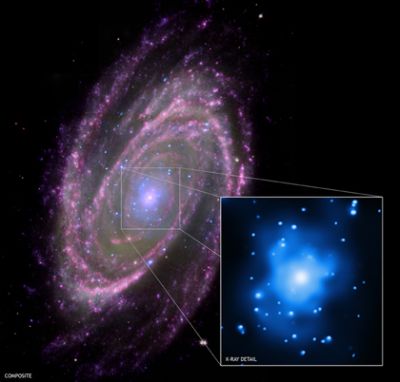02 July 2008

Image Credit: NASA/CXC/Wisconsin/D.Pooley & CfA/A.Zezas; Optical: NASA/ESA/CfA/A.Zezas; UV: NASA/JPL-Caltech/CfA/J.Huchra et al.; IR: NASA/JPL-Caltech/CfA
This composite NASA image of the spiral galaxy M81, located about 12 million light years away, includes X-ray data from the Chandra X-ray Observatory (blue), optical data from the Hubble Space Telescope (green), infrared data from the Spitzer Space Telescope (pink) and ultraviolet data from GALEX spacecraft (purple). The inset shows a close-up of the Chandra image. At the center of M81 is a supermassive black hole that is about 70 million times more massive than the Sun.
A new study using data from the space-based Chandra and ground-based telescopes, combined with detailed theoretical models, demonstrates that the supermassive black hole of M81 consumes surrounding material at rates just similar to those of stellar-mass black holes, with masses of only about ten times the solar mass. This finding bolsters the implication of Einstein's relativity theory that black holes of all sizes show similar properties, and will be helpful for predicting the properties of a conjectured new class of black holes.
Five sophisticated telescopes that observe the cosmos in the radio and millimeter ranges, and an optical observatory were also applied to study M81. Chandra is the only X-ray space observatory able to isolate the faint X-rays of the black hole from the emission of the rest of M81. A team led by Sara Markoff of the Astronomical Institute, University of Amsterdam, conducted the study.
The supermassive black hole in M81 generates energy and radiation as it pulls gas in the central region of the galaxy inwards at high speed. Therefore, the model that Markoff and her colleagues used to study the black holes includes a faint disk of material spinning around the black hole. This structure would mainly emit X-rays and visible light. A region of hot gas around the black hole would be detectable largely in ultraviolet and X-rays. A large contribution to both the radio and X-ray light comes from jets generated by the black hole. Multi-wavelength data is crucial for disentangling these overlapping sources of light.
M81 is visible among the stars of the constellation Ursa Major, the Great Beat. It is the dominant member of a gravitationally-bound group of 34 galaxies. M81 is a spectacular example of a spiral galaxy, with well defined spiral arms emanating from the galaxy’s core. M81 is actually in a gravitational interaction with two nearby galaxies, known as M82 and NGC 3077, respectively. Intriguingly, this encounter stimulated a vigorous star formation process in M82.
Further Reading
Chandra Observatory Press Release
http://chandra.harvard.edu/press/08_releases/press_061808.html
Aymen Mohamed Ibrahem
Senior Astronomy Specialist